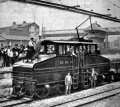Electric Pantographs
The pantograph is a mechanism for supporting a conductor for drawing electricity from the catenary (overhead wires) down to the electric locomotive as it travels along the track. Prior to electrical use, a pantograph was a draughtman's tool. It could be used to copy a drawing, and -- by adjusting the extension -- could enlarge or reduce the copied drawing. In 1803, James Hawkins used the principles of the pantograph to patent a device that people could used to make copies of their outgoing letters in the age before copying machines. Thomas Jefferson owned one of these "polygraphs" (as they were called up until 1871, not to be confused with the later lie-detection device).[1]
The hinges of a pantograph allowed it to adjust for varying heights in the overhead wire, making it ideal for adapting to electric railways. As electric locomotive speeds increased, the pantographs became more complex. Locomotives often carried two pantographs, one at either end.



